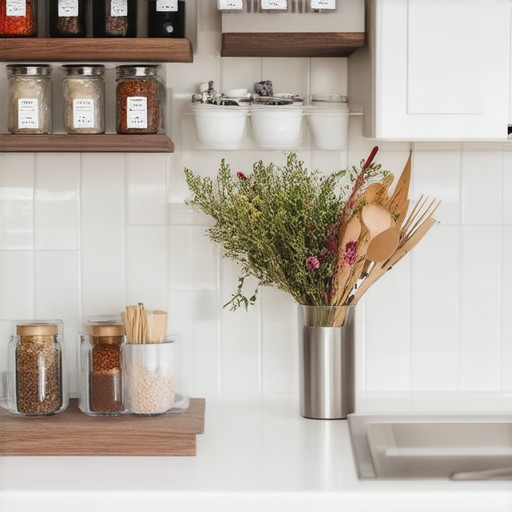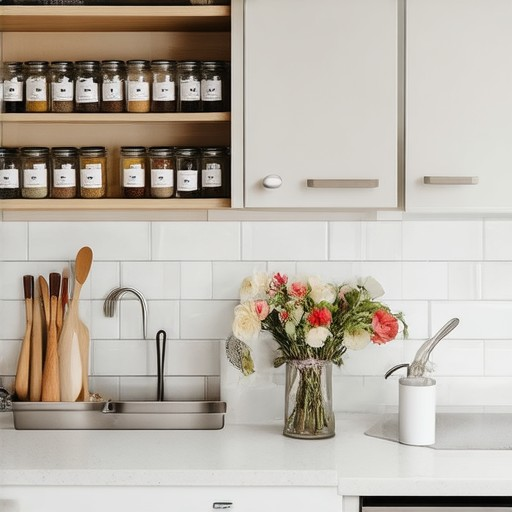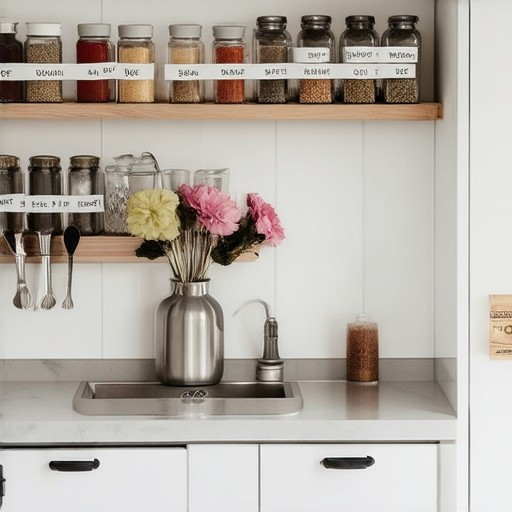Clutter and disorganization often seem like insurmountable challenges, but with the right creative home organization strategies, anyone can transform their living space into a haven of efficiency and peace of mind. Whether you’re struggling with overwhelming amounts of belongings, navigating the unique demands of ADHD, or simply seeking affordable ways to maximize your home’s potential, this guide offers a wealth of practical solutions. From budget-friendly DIY projects to innovative storage solutions, we’ll explore how to declutter quickly, maintain order long-term, and infuse your home with style while keeping it highly functional. Discover how creative home organization can not only streamline your daily life but also enhance your mental clarity and overall well-being. Let’s dive into the tips, tricks, and ideas that will help you create a clutter-free environment that truly reflects your personal style and lifestyle.

How Much Does Home Organization Cost?
The cost of home organization can vary widely depending on the extent of the project, the level of expertise required, and whether you opt for professional help or DIY solutions. Here’s a breakdown of the typical costs:
Professional Organizers
- Hourly Rates: Professional organizers typically charge between $50 and $150 per hour. This rate may vary based on experience and location.
- Minimum Hours: Many reputable firms require a minimum service time, often ranging from 3 to 8 hours.
- Total Costs: Basic organization efforts can range from $300 to $800, while extensive projects may cost upwards of $2,500 or more.
D.I.Y. Solutions
- Tools and Storage: Purchasing organizational tools like bins, shelves, and drawer organizers can cost between $100 and $300.
- Storage Solutions: Installing cabinets, closet systems, or other storage units may cost between $500 and $2,000.
- Custom Furniture: Custom-built-in furniture or cabinetry can range from $1,500 to $5,000 or more.
Smaller Tasks
- Decluttering Small Spaces: Organizing a small room or area can cost between $200 and $600.
- Whole House Organization: Full-scale organization of an entire home can range from $1,000 to $3,000.
Additional Considerations
- Consultation Fees: Some organizers may charge for an initial assessment or consultation.
- Duration: The timeline for seeing noticeable results can vary from a few days to several weeks, depending on the scope of the project.
Budget Tips
- DIY Options: For those comfortable with tools and home improvement projects, DIY solutions can be cost-effective, though they require time and effort.
- Professional Help: Hiring a professional organizer can save time and reduce stress, making it worth the investment for many.
By understanding your specific needs and obtaining a detailed quote, you can determine the best approach to achieving a organized home within your budget.
How to Organize Your House with Too Much Stuff
Organizing a house filled with too much stuff can seem daunting, but with the right strategy, it becomes manageable. Start by following the 5-box decluttering method:
- Donation Box: Identify items you no longer need or that no longer fit your lifestyle. These can be donated to local charities or given to friends in need.
- Trash Box: Discard items that are broken, damaged, or no longer useful. Properly dispose of waste to keep your space clean.
- Relocate Box: Move items you may need in the future, such as seasonal clothing or decor, to a designated area.
- Keep Box: Only retain items you use regularly and are essential. This helps reduce clutter and keeps frequently used items accessible.
- Recycle Box: Separate recyclable materials like paper, glass, and plastic. Check local guidelines for correct disposal methods.
After sorting your items into these categories, clean each room thoroughly. Wipe down surfaces, vacuum floors, and sanitize to eliminate dust and allergens. Consider implementing organizational systems like shelving or drawer organizers to keep your space tidy.
Be realistic about what you can keep. Let go of items that no longer serve a purpose. Set a rule, such as donating items you haven’t used in six months, to maintain a clutter-free environment.
Maximize vertical space with wall shelves or hanging organizers. Use clear labels on boxes and containers to enhance accessibility and maintain order. Regularly maintain your space with weekly tidy-ups to prevent clutter from returning.
By tackling the organization process one room or task at a time, you can manage the overwhelm and achieve a more orderly home. Keep track of your progress to stay motivated and enjoy the benefits of a neater, more functional living space.

How to Organize Your House with ADHD
Organizing a house can feel overwhelming, especially when dealing with ADHD. However, with the right strategies, it becomes manageable and even enjoyable. Here’s a step-by-step guide to help you create a calm and clutter-free environment:
1. Start Small
ADHD often leads to feeling overwhelmed, so focus on one room or area at a time. Begin with a less stressful space, like the bedroom or bathroom, and gradually move on to larger areas like the living room or kitchen.
- Choose a Starting Point: Select the most chaotic area and commit to organizing it completely before moving on.
- Set a Time Limit: Give yourself 15-30 minutes to work on the space, avoiding the urge to perfectionism.
2. Create a System
Establish a system that works for you, not against you. Use visual cues and simple tools to stay on track.
- Use Visual Cues: Labels, color-coded bins, or clear containers can help you quickly identify where items belong.
- Keep It Simple: Avoid complicated systems. Focus on what works best for your routine and energy levels.
- Consider Time Blocking: Allocate specific times during the day for organizing tasks to reduce decision fatigue.
3. Declutter Effectively
Clutter is a big challenge for many with ADHD. Approach decluttering with intention and create a sustainable system for your belongings.
- Ask Yourself “Does This Bring Value?”: Keep only items that are useful, loved, or needed. Let go of anything that doesn’t serve you.
- Use the “One In, One Out” Rule: When organizing a space, follow this rule to prevent clutter from returning.
- Digitize Where Possible: Scan and store digital copies of important documents to reduce physical clutter.
4. Establish a Daily Routine
A consistent daily routine can significantly reduce chaos and help you maintain order.
- Morning Routine: Start your day by picking up clothes and preparing for the next day. Keep a small basket near your bed for quick pickups.
- Evening Routine: Spend a few minutes each evening putting away toys, dishes, and other items. Keep a cleaning caddy nearby for easy access.
- Weekly Tasks: Schedule regular cleaning and organizing sessions to keep on top of things throughout the week.
5. Utilize Tools and Tricks
There are plenty of tools and tricks designed specifically to help those with ADHD organize their homes effectively.
- Chronic List Maker: Write down tasks and deadlines on a whiteboard or sticky notes. Cross off completed items to boost your sense of accomplishment.
- Visual Timelines: Use a calendar or timeline to track upcoming events and deadlines, helping you stay focused and prepared.
- Color-Coding: Assign colors to different types of tasks or rooms to make decision-making easier and more intuitive.
6. Seek Support
Don’t hesitate to ask for help when you need it. Organizing can be lonely, and having someone by your side can make the process much smoother.
- Hire a Professional Organizer: If you’re struggling on your own, consider hiring a professional who understands ADHD challenges.
- Join Support Groups: Connect with others who have ADHD to share tips and strategies for organizing your home.
- Family and Friends: Enlist help from family members or friends who can offer support and encouragement.
By implementing these strategies, you can create a more organized and peaceful home environment. Remember, progress is more important than perfection. Celebrate small victories along the way!

How to Organize a Cluttered House Fast
The fastest way to organize a cluttered house begins with a strategic approach. Here’s a step-by-step guide to declutter and restore order efficiently:
- Step 1: Assess and Prioritize
- Scan each room to identify the most cluttered areas.
- Use a simple tool like a decluttering app to track progress.
- Step 2: Create a Declutter Plan
- Categorize items into four groups: keep, donate, sell, or throw away.
- Set realistic deadlines for completing each area.
- Step 3: Tackle One Room at a Time
- Start with high-traffic zones like entryways and kitchens.
- Use a trash bag for items to donate or throw away.
- Step 4: Declutter Efficiently
- Be ruthless—ask yourself, “Does this item bring value?”>
- Utilize local donation drop-off centers or online platforms.
- Step 5: Reorganize with Purpose
- Focus on frequently used items for quick access.
- Invest in storage solutions like labeled bins and shelving.
- Step 6: Maintain Order Long-Term
- Schedule weekly scans to prevent future clutter.
- Plan an annual spring cleaning session.
By following these steps, you can declutter and organize your house faster while keeping it maintained. Remember, consistency is key to preventing clutter from returning.
The 121212 Rule for Decluttering
The 121212 rule for decluttering is a simple yet effective strategy to help you organize and streamline your living space. This rule is designed to make the process easier by guiding you through a structured approach to deciding what to keep and what to let go.
This rule works by categorizing your belongings based on their usage frequency:
- 1 – Weekly Use: Keep items you use at least once a week. These are essentials for your daily life and routines.
- 2 – Monthly Use: Retain items you use about twice a month. These can be seasonal items or those you don’t need every day.
- 1 – Seasonal Use: Store away items you only need once a year or during specific seasons. These can be packed away to save space.
- 2 – Never Use: Let go of items you haven’t used in the past year. These are unlikely to be needed again and can be donated or sold.
By applying the 121212 rule, you can systematically evaluate your possessions and create a more organized and clutter-free environment. This method ensures that you keep only what is necessary and frequently used, allowing you to focus on what truly adds value to your life.

What Should I Remove First When Decluttering?
When decluttering your home, it’s important to approach the process systematically to maximize efficiency and minimize overwhelm. Here’s a step-by-step guide to help you determine what to remove first:
-
Identify Large Items : Begin by removing the largest and most bulky items. These include furniture pieces like sofas, coffee tables, and bookshelves, as well as appliances such as refrigerators and washing machines. Removing these items first creates immediate visual relief and frees up space, making the remaining tasks feel more manageable.
-
Tackle Easy-to-Decline Items : Start with items you’re confident you no longer need or want. This could include outdated clothing, broken electronics, or knick-knacks that hold no sentimental value. Removing these first builds momentum and boosts your confidence for tackling tougher decisions later.
-
Categorize and Evaluate : Before diving in, take inventory of your belongings. Separate items into categories such as “keep,” “discard,” and “maybe.” Ask yourself questions like, “Do I truly need this?” or “Have I used this in the past year?” This helps you make objective decisions about what stays and what goes.
-
Apply the “One In, One Out” Rule : As you bring in new items, consider removing one older piece to make space for the new. This prevents clutter from returning and encourages a mindful approach to accumulation.
-
Prioritize High-Traffic Areas : Focus on areas where you spend the most time, such as the kitchen or living room. Clearing out expired foods, unused appliances, or duplicate tools in the kitchen can significantly reduce daily stress and improve functionality.
By following this plan, you can efficiently declutter your home while addressing both physical and emotional challenges.




0 Comments